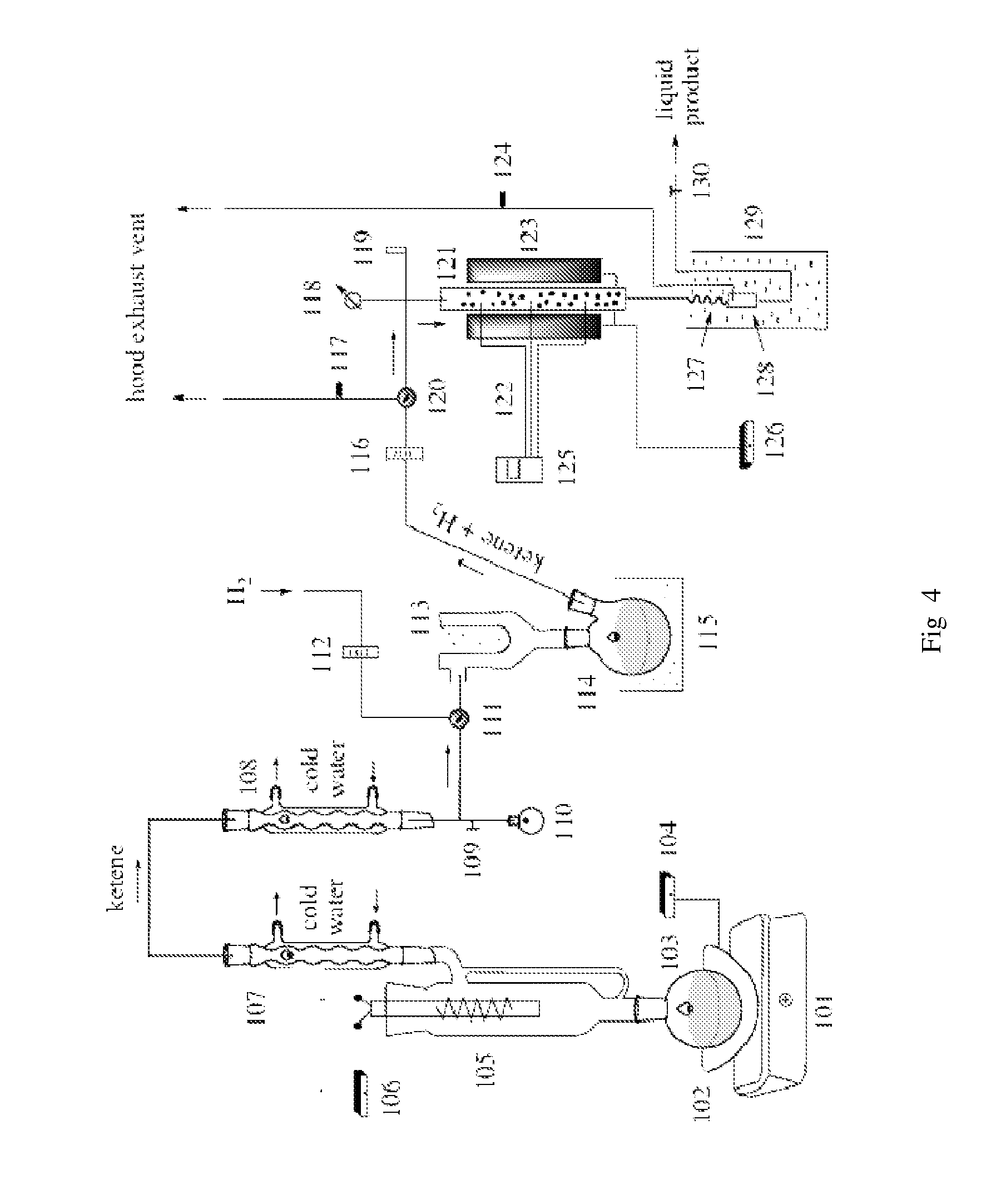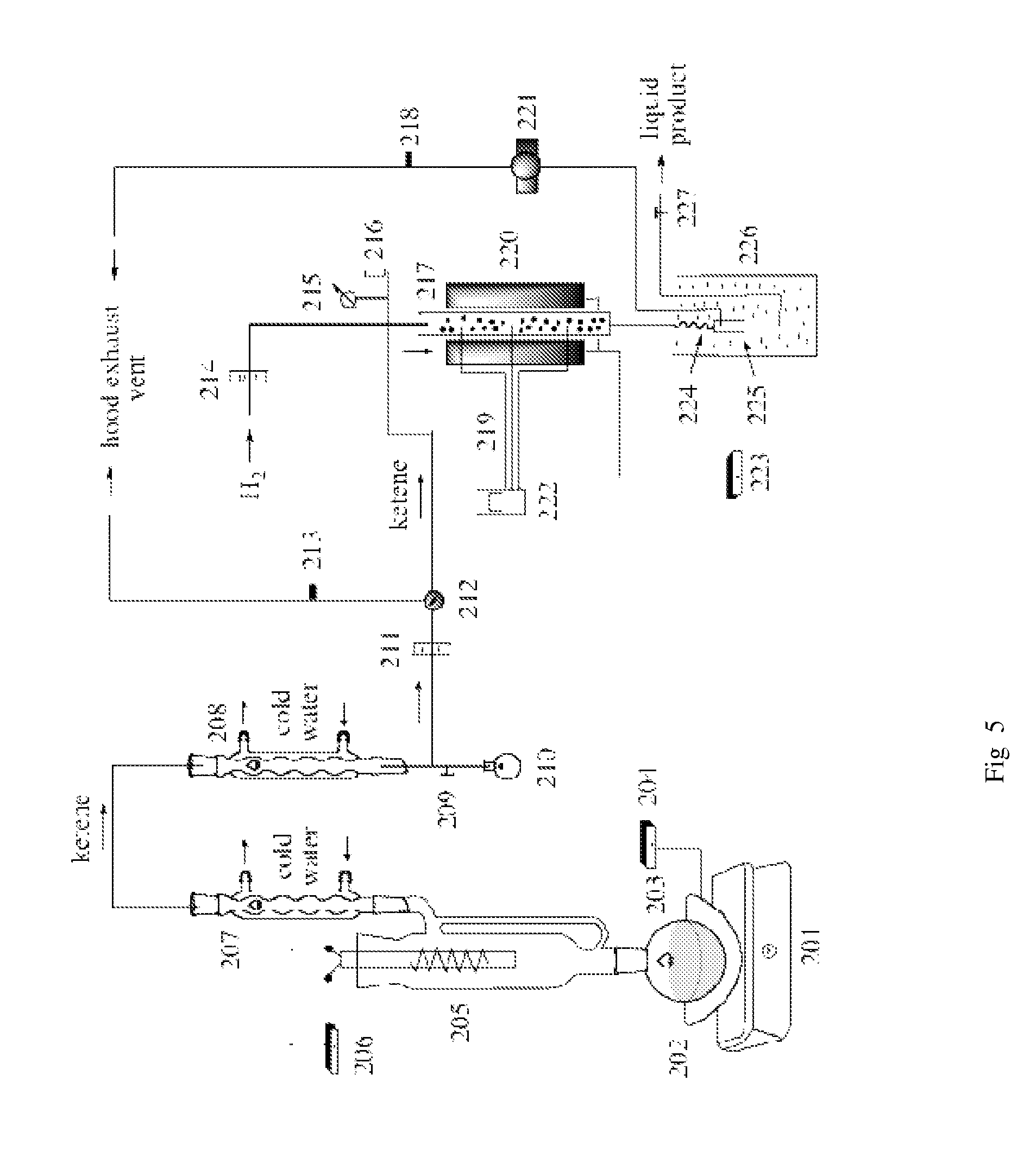Synthesis of ethanol and higher alcohols by hydrogenation of ketene
a technology of ketene and ethanol, which is applied in the preparation of carbonyl compounds, oxygen-containing compounds, fuels, etc., can solve the problems of inability to meet the needs of ethanol production, inability to achieve satisfactory technologies, and difficulty in isolation of butanol from broth along with its toxicity to microorganisms
- Summary
- Abstract
- Description
- Claims
- Application Information
AI Technical Summary
Benefits of technology
Problems solved by technology
Method used
Image
Examples
experiment 1
[0049]Synthesis of Ketene and Hydrogenation: A 1 lit RB flask 103 was filled with about 600 ml of acetone, placed on a heating mantle 102 on a magnetic stirrer 101 and a ketene lamp 105 was fitted on the neck of the flask (see FIG. 4). The top of the ketene lamp was connected to two reflux condensers 107 and 108 connected in series with the bottom of the second connected to a 50 ml RB flask 110 with a side arm from the bottom for ketene gas to flow to an outlet with a hose connector to a Dewar condenser 113,114,115. The connection between the ketene lamp and the Dewar condenser was fitted with a three way valve 111. The valve allowed switching of flow from the ketene reactor to flow of hydrogen gas from a hydrogen cylinder. The hydrogen line was fitted with a rotometer 112. The outlet from the Dewar condenser could be vented to the hood outlet or into a hydrogenation reactor. The hydrogenation reactor consisted of a 1 inch stainless steel tube 121 fitted with thermocouples 122 insid...
experiment 2
[0052]Synthesis and Hydrogenation of Ketene: A 1 lit RB flask 203 was filled with about 600 ml of acetone, placed on a heating mantle 202 on a magnetic stirrer 201 and a ketene lamp 205 was fitted on the neck of the flask (see FIG. 5). The top of the ketene lamp was connected to two reflux condensers 207 and 208 connected in series with the bottom of the second connected to a 50 ml RB flask 210 with a side arm from the bottom of the condenser for ketene gas to flow to an outlet with a hose connector to a silicone tube connected to a three way ball valve 212. One out from the ball valve was connected to a hose that vented to the hood exhaust and the other out from the ball valve 212 was connected to a hydrogenation reactor inlet. A rotometer 211 was connected to measure ketene gas / methane from the ketene lamp as it flowed into the hydrogenation reactor or vented to the exhaust. The hydrogenation reactor which was connected at its top to a hydrogen gas line with a rotometer 214 to mea...
experiment 3
[0053]Synthesis and Hydrogenation of Ketene: The ketene generation apparatus was as described in the experiment above except that the 1 liter, one neck RB flask was replaced by a two neck flask 303 (see FIG. 6). The side neck was connected to a ground glass outlet that was connected to a rotometer 305 on a argon line to sweep the argon gas into the hydrogenation reactor instead of applying vacuum. The ketene lamp was started after the acetone was refluxing and ketene vented to the exhaust to establish a steady rate for about 10 minutes. GCMS samples were taken indicating ketene, methane and some acetone vapor was in the product from the ketene lamp. The hydrogenation reactor containing 77 gms of reduced Copper zinc oxide catalyst was heated to about 200° C. and hydrogen flow was set to 300 ml / min as the ketene gas was passed through the reactor for hydrogenation. The liquid condenser was cooled in an ice salt water bath and gas and liquid samples were taken. The samples showed compl...
PUM
| Property | Measurement | Unit |
|---|---|---|
| Volume | aaaaa | aaaaa |
| Residence time | aaaaa | aaaaa |
Abstract
Description
Claims
Application Information
 Login to view more
Login to view more - R&D Engineer
- R&D Manager
- IP Professional
- Industry Leading Data Capabilities
- Powerful AI technology
- Patent DNA Extraction
Browse by: Latest US Patents, China's latest patents, Technical Efficacy Thesaurus, Application Domain, Technology Topic.
© 2024 PatSnap. All rights reserved.Legal|Privacy policy|Modern Slavery Act Transparency Statement|Sitemap



